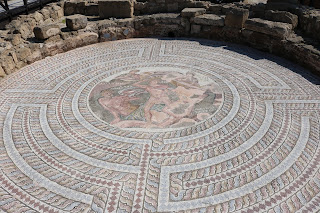Cyprus EUrevoir
 |
| Looking West from Petra Tou Romiou |
I'm not sure if Mister E and I have invented our latest challenge or if perhaps we read about it somewhere. After all, it's a little out of character for us to be unique. Regardless, we are embracing EUrevoir which briefly involves an effort to visit every EU nation before the United Kingdom's transition period expires on 31st December.
We have already banked a few since the referendum result in case we can't get to them all this year and, of course, coronavirus might be something of an impediment, but we'll deal with that when we have to.
In the interim, we kicked the whole thing off in style with a week in Cyprus, returning yesterday. Europe with hot sunshine in February, what is there not to like about that?
Cyprus is renowned as a tourist destination with a solid infrastructure: modern buildings, roads, public transport network and broadband, for those who want that kind of thing when travelling. The Cypriots also drive on the left and their signage is in English, which is of course widely spoken too. Well it would be, considering that the British only withdrew from controlling the island in 1960 and still retain parts for strategic bases (more Brexit Border nightmares).
We stayed in Paphos: the inevitable concrete ribbon development was alleviated by archaeological excavations wherever we wandered, including the World Heritage sites of The Tombs of the Kings and the Roman city of Kato Paphos with its amazing mosaics.
 |
| Catacombs/Burial chambers at Tombs of the Kings |
 |
| Mosaics at Kato Paphos |
There is the beautiful pebble beach and scenery at Petra Tou Romiou where Aphrodite is fabled to have come ashore.
 |
| Petra To Romiou |
The medieval Ottoman period is preserved with bath houses.
The harbour is recognised by its fort.
Paphos is even one of the oldest places in Christianity after St Paul arrived on his travels in or about 45AD. He is credited with converting the Roman Pro-Consul of the city but only after allegedly being tied to a pillar and flogged there. The reputed pillar, lying amidst an excavated site of early Christian churches dating back to the 4th Century AD, is marked, although historic evidence for its authenticity would appear to be lacking.
 |
| St Paul's Pillar |
The upper or old town has been very much rebuilt in recent years and is still undergoing reconstruction. You can have a pleasant stroll spotting the street art, much of it from its status as EU Capital of Culture in 2017.
A mosque converted from a Byzantine church in 1570 and abandoned when the Turkish Cypriots fled, remains a prominent feature of Paphos' skyline. It is now cared for by the Department of Antiquities and is closed for ongoing restoration.
Evocative bronze statues by local sculptor, Yiota Ionnadou, are also on display around the town.
 |
| The Little Fisherman |
 |
| The Girl with a Sparrow |
There is a large indoor market with sounds and smells reminiscent of North African souks.
This is not Greece. The language and food to a foreigner appear similar but the ambience is more cosmopolitan. There was neither bouzouki music nor vine clad beach tavernas.
There were cats. Apparently they were originally imported in the time of Alexander the Great to control the snake population. We didn't see any snakes but the cats have clearly multiplied. Unlike in many other Mediterranean towns however, Paphos seems to be counteracting the effect through kindness. The cats are well-fed and for the most part, they have been speyed or neutered as indicated by a nick in their ear.
Renowned for being unbearably hot in the summer, the past week proved an excellent time of year for a visit. With only one day of rainfall, we enjoyed gentle breezes and temperatures of 17 to 18 degrees (it felt much hotter in the sun). There were no biting flies and they were perfect conditions for walking and exploring both on foot and by local bus.
What a way to avoid what turned out to be a very cold week at home with snow.

























.JPG)







Comments